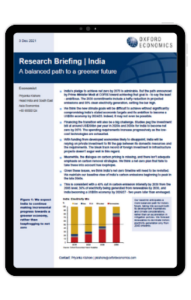Research Briefing
| Dec 8, 2021
A balanced path to a greener future for India

India’s pledge to achieve net zero by 2070 is admirable. But the path announced by Prime Minister Modi at COP26 toward achieving that goal is – to say the least – ambitious. The 2030 commitments include a hefty reduction in projected emissions and 50% clean electricity generation, setting the bar high.
What you will learn from this report:
- We think the new climate goals will be difficult to achieve without significantly compromising India’s stated economic targets and its ambition to become a US$5tn economy by 2024/25. Indeed, it may not even be possible.
- Financing the transition will also be a big challenge. Studies peg the investment bill at around US$200bn per year in 2020s and 2030s for India to become net zero by 2070. The spending requirements increase progressively as the low-cost technologies are exhausted.
- With funding from developed economies likely to disappoint, India will be relying on private investment to fill the gap between its domestic resources and the requirements. The bleak track record of foreign investment in infrastructure projects doesn’t augur well in this regard.
Tags:
Related Services


Post
Rise of new megacities will drive global urban growth
The population of the world's 1,000 largest and most important global cities is forecast to increase by more than half a billion by 2050. However, this urban demographic growth is not equally distributed across the world's cities.
Find Out More